
The homing pigeon, also called the mail pigeon or messenger pigeon, is a variety of domestic pigeons derived from the wild rock dove, selectively bred for its ability to find its way home over extremely long distances. The rock dove has an innate homing ability, meaning that it will generally return to its nest using magnetoreception. Flights as long as 1,800 km have been recorded by birds in competitive pigeon racing. Their average flying speed over moderate 965 km distances is around 97 km/h and speeds of up to 160 km/h have been observed in top racers for short distances.
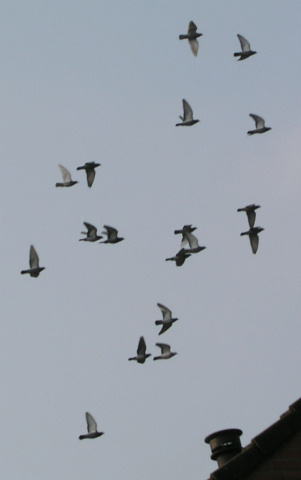
Pigeon racing is the sport of releasing specially trained homing pigeons, which then return to their homes over a carefully measured distance. The time it takes the animal to cover the specified distance is measured and the bird's rate of travel is calculated and compared with all of the other pigeons in the race to determine which animal returned at the highest speed.
Fancy pigeon refers to any breed of domestic pigeon, which is a domesticated form of the wild rock dove. They are bred by pigeon fanciers for various traits relating to size, shape, color, and behavior, and often exhibited at pigeon shows, fairs and other livestock exhibits.

The Fantail is a popular breed of fancy pigeon. It is characterised by a fan-shaped tail composed of 30 to 40 feathers, abnormally more than most members of the dove and pigeon family, which usually have 12 to 14 tail feathers. The breed is thought to have originated in Pakistan, India, China, Japan or Spain. There are several subvarieties, such as the English Fantail, the Indian Fantail, and the Thai Fantail. Charles Darwin used it as one of the examples in the first chapter of his book On the Origin of Species. He believed it was a descendant of the rock dove.
The tippler is a breed of domestic pigeon bred to participate in endurance competitions. Flying results of up to 22 hours (non-stop) have been reported.

The domestic pigeon or city dove is a pigeon subspecies that was derived from the rock dove. The rock pigeon is the world's oldest domesticated bird. Mesopotamian cuneiform tablets mention the domestication of pigeons more than 5,000 years ago, as do Egyptian hieroglyphics. Research suggests that domestication of pigeons occurred as early as 10,000 years ago.

Pigeon keeping or pigeon fancying is the art and science of breeding domestic pigeons. People have practiced pigeon keeping for at least 5,000 years and in almost every part of the world. In that time, humans have substantially altered the morphology and the behaviour of the domesticated descendants of the rock dove to suit their needs for food, aesthetic satisfaction and entertainment.

The Pouter pigeons are domesticated varieties of the rock dove, Columba livia, characterized by a very large, inflatable crop. They are kept as ornamental or fancy breeds, valued for their unusual appearance. There are many varieties of pouter with little in common except for the nature of the crop. The origin of the breed group is unknown, but Pouters have been bred in Europe for at least 400 years.
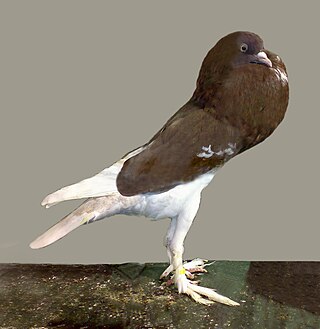
The English Pouter is a breed of fancy pigeon developed over many years of selective breeding. English Pouters, along with other varieties of domesticated pigeons, are all descendants from the rock pigeon. A breed with an enlarged crop, their distinctiveness was described by Charles Darwin in The Variation of Animals and Plants Under Domestication (1868).
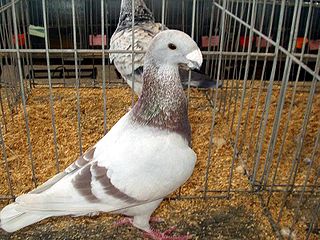
The German Beauty Homer is a breed of fancy pigeon developed over many years of selective breeding, from German racing pigeons. German Beauty Homers along with other varieties of domesticated pigeons are all descendants of the rock dove. The breed was first developed around one hundred years ago.

The Indian Fantail is a breed of fancy pigeon developed over many years of selective breeding. Indian Fantails, along with other varieties of domesticated pigeons are all descendants of the rock dove.

The Pigmy Pouter is a breed of fancy pigeon developed over many years of selective breeding. Pigmy Pouters, along with other varieties of domesticated pigeons, are all descendants from the rock pigeon.
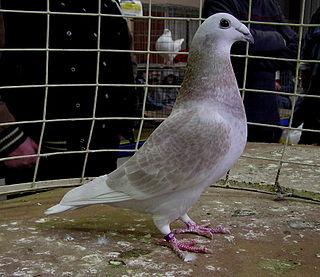
The British Show Racer is a breed of fancy pigeon developed over many years of selective breeding. The British Show Racer along with other varieties of domesticated pigeons are all descendants from the rock pigeon. As the name suggests, this breed was developed as an exhibition breed in Britain from local stocks of racing pigeons. Douglas McClary in his book Pigeons for Everyone describes Show Racers as simply the "show version" of the popular racing pigeon.
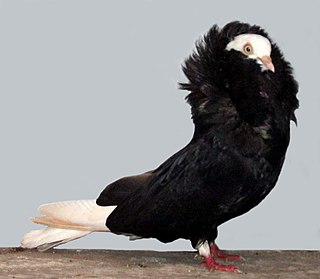
The Old Dutch Capuchine is a breed of fancy pigeon developed over many years of selective breeding. Old Dutch Capuchines, along with other varieties of domesticated pigeons, are all descendants of the rock dove.

The Sebright is a British breed of bantam chicken. It is a true bantam – a miniature bird with no corresponding large version – and is one of the oldest recorded British bantam breeds. It is named after Sir John Saunders Sebright, who created it as an ornamental breed by selective breeding in the early nineteenth century.

Utility pigeons are domesticated pigeons bred to be a source of meat called squab. Squabs have been used as a food in many nations for centuries. They were bred to breed and grow quickly. Because they are bred for squab production, conformation to a show standard is usually deemed unimportant.
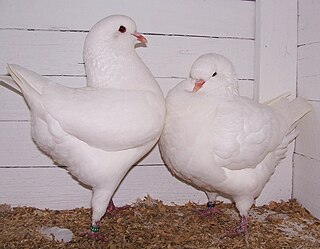
The King pigeon is a breed of pigeon developed over many years of selective breeding primarily as a utility breed. Kings along with other varieties of domesticated pigeons are all descendants from the rock dove.
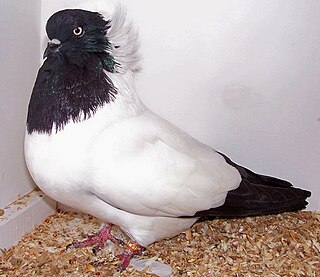
The Nun is a breed of fancy pigeon developed through many years of selective breeding. It was known as the Dutch Shell Pigeon in continental Europe. Nuns, along with other varieties of domesticated pigeons, are all descendants from the rock pigeon . The Nun is one of the oldest breeds and was originally a flying tumbler before being developed for exhibition. It is a mostly white breed, with a hood of feathers, which gives the name to the breed.
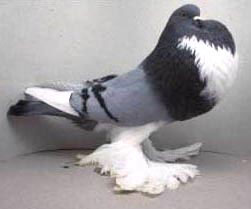
The Dutch Cropper is the oldest and largest National fancy pigeon breed in the Netherlands.

















